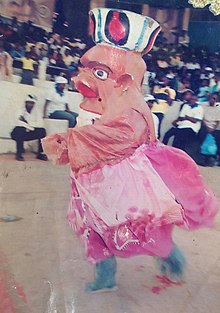Kwagh-Hir
It is used by the Tiv people to reinforce traditional beliefs and convey other worldly tales to educate, socialize, provide secular entertainment and address societal issues.
[4] The most familiar variant of the kwagh-hir according to Jonathan Fogel may be the Punch and Judy show, in which recognizable characters lampoons current political figures and events in the news while also referencing an array of cultural mores.
[5] Kwagh-hir was inscribed on the Representative List of the Intangible Cultural Heritage of Humanity in 2019 by the decision of the Intergovernmental Committee: 14.COM 10.B.27.
[3][6] Legend has it that Adikpo Songo from Akpagher; Mbatyav in the present day Gboko local government area of Benue State, Nigeria, was the originator of Kwagh-hir.
Songu, an ardent supporter of the United Middle Belt Congress (UMBC) revealed that in December 1960 during the outbreak of the political crisis in Tivland known as Nande-Nande (the burning cycle) whereby members of the UMBC rose against the ruling Northern People's Congress (NPC), burning their properties, including that of government workers and chiefs, he had escaped to Mkar Christian Hospital, near Gboko, for medical treatment, but deductively, to escape arrest from the police.
On his way back from Mkar Christian Hospital, having traveled for about 12 miles, he arrived near the Orkoor River when suddenly he heard the sound of fascinating music.
A white flag was hoisted in-between the two groups which both had a band of drummers, dancing girls and puppets on a dagbera (platform).
Adikpo Songu says he fell asleep watching the spectacle, and upon waking up the following morning, there was nothing in the vicinity to show that an event of such had taken place in the location.
So he came to the conclusion that the adzov must have deliberately selected him for the purpose of entrusting him with the responsibility of bringing kwagh-hir to the Tiv people, and humanity in the form and style he had been privileged to watch.
The Nyambuan performance came with intense social, political implications and sought to re-establish order through cathartic performances aimed at abolishing the Tiv exchange marriages known as yamen-ishe (roughly translated as trading value) and restoring the cultural disruptions imposed on the Tiv people by the colonial structures.
[10][11] The Kwagh-hir, which later emerged and is practised today, de-emphasises dialogue because of the brutality with which the Nyambuan cult dramatists were suppressed by the combined efforts of the missionaries and the British colonial government.
It incorporates certain Tiv social dances like swange, gberichul, ihinga, ivom, iee, igbe, ibiamegh, girinya and other comic forms.
Historical awareness is shown in some puppets which represents events such as when the first woman emerged or when modern dress styles of European design gained local acceptance.
[17] Each of the masks and masquerade objects are crafted to depict symbolic action and movement that explains aspects of the Tiv worldview.



